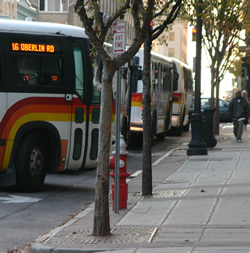Transit easements. They aren’t the most exciting thing in the world, but they are emerging as part of Raleigh’s plans to become a multimodal city.
Transit easements allow transit systems, such as Capital Area Transit, to use private property as a bus stop or bus corridor. For example, bus service through Crabtree Valley Mall is provided by a transit easement.
Members of the City Planning department now ask developers for a transit easement when they come in to rezone their properties.
The key word is “ask.”
When a property owner wants to rezone his property, there are often conditions attached. These conditions could be anything, but often they limit height or certain uses. For example, a rezoning application could add that as a condition of approval, there won’t be any drive-thru businesses.
These conditions often include a transit easement for future bus service.
Transportation Planning Manager Eric Lamb said the city can only suggest or recommend conditions. City planning staff can suggest that a developer include a transit easement, but they can’t mandate it.
Transit easements are frequently suggested for developments that have future or expected use and are near other transit stops. While there might not be a bus stop there now, it provides the city the flexibility it will need as the transit system grows.
A recent case coming through Planning Commission is a project on Spring Forest Road, which includes some residential development on a neighboring property. In this case, there is an existing bus stop a little more than a quarter of a mile away.
Because the project is expected to have residential development, and the nearest bus stop is more than a quarter of a mile away, Commissioner Adam Terando asked that developer to include a transit easement.
In this particular case, the developer didn’t include an easement because he believed there is a conflict with another part of the zoning code that pertains to tree conservation.
“We need to start thinking of transit on equal footing,” to other kinds of transportation, Terando told the Record.
He said that nine times out of 10, developers include easements without any questions or conflict.
“I wish that we could ask more of the development community,” he said.
